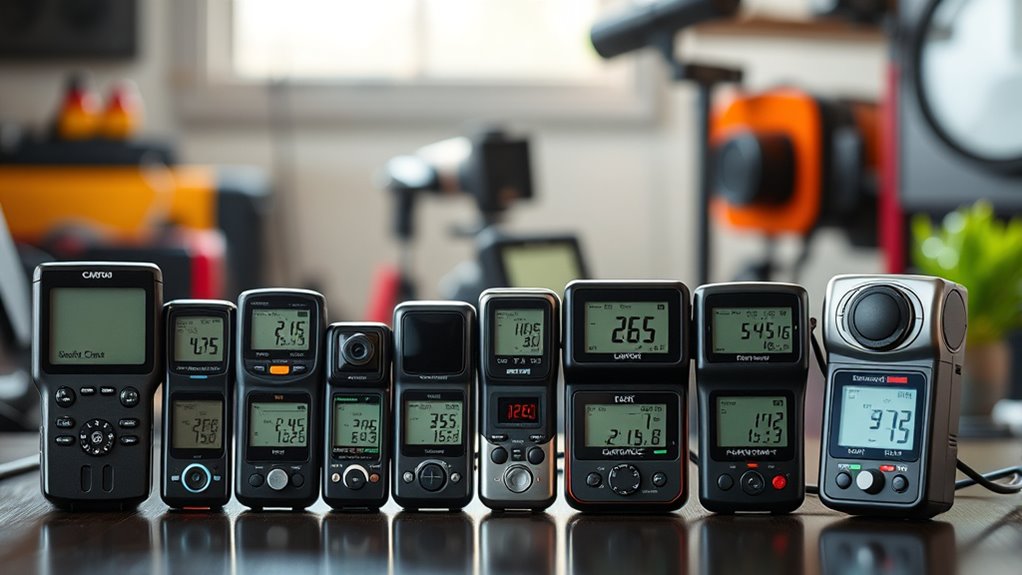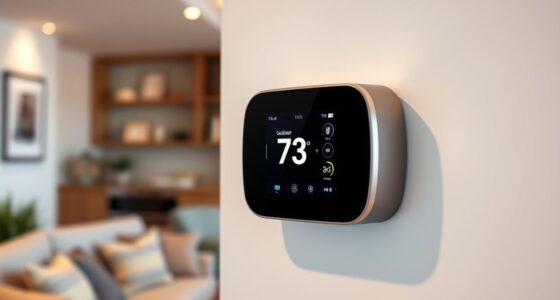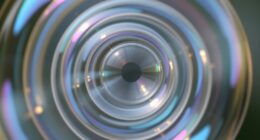If you’re looking to elevate your photography skills in 2025, a quality light meter is essential. I recommend the ProsKit MT-4617LED for budget-friendly options, while the BTMETER BT-881D and Dr.meter LX1330B offer precision and versatility. For professional quality, check out the Klein Tools ET130 or the Sekonic L-308X-U. Each meter has unique features suited to different needs. Stick around and I’ll highlight more options that can truly enhance your photographic journey.
Key Takeaways
- Consider the measurement range and accuracy of light meters, with options ranging from 0.01 Lux to over 400,000 Lux for various applications.
- Look for user-friendly features such as backlit displays, data hold functions, and compact designs to enhance portability and usability.
- Evaluate models with Bluetooth connectivity for easy data transfer and tracking, ideal for professional photographers and lighting specialists.
- Assess the build quality and durability, especially for outdoor or frequent use, to ensure longevity of the device.
- Read customer reviews and feedback to gauge performance and reliability, particularly for specific tasks like photography and plant care.
ProsKit MT-4617LED LED Light Intensity Meter
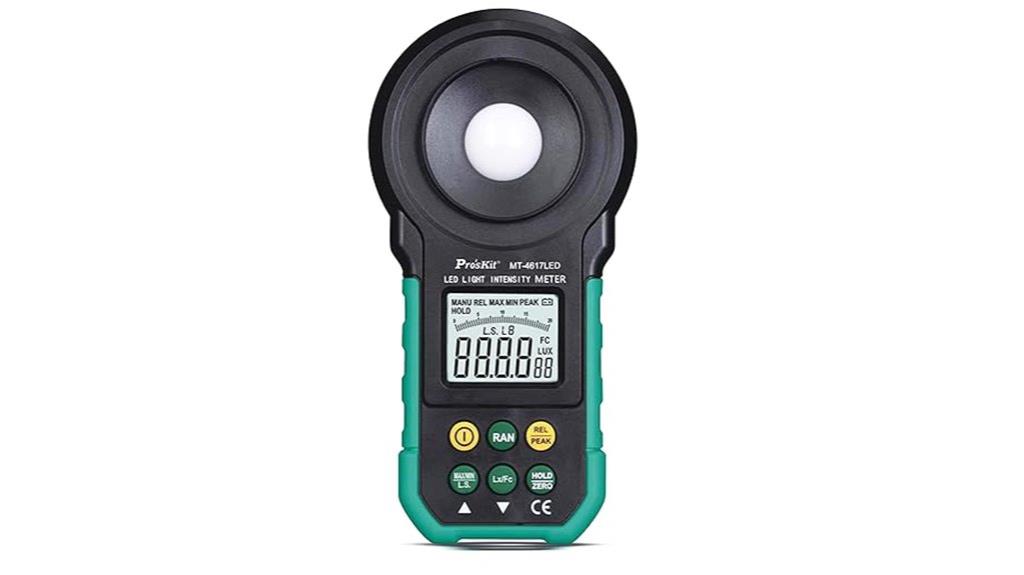
If you’re a hobbyist or DIY enthusiast looking for a reliable and affordable light meter, the ProsKit MT-4617LED LED Light Intensity Meter could be just what you need. It measures all visible light and LED colors up to 200,000 Lux, making it perfect for various projects. I found it user-friendly, with a quick setup using a 9V battery. Its lightweight design makes it easy to carry around. While it may lack some advanced features and precision, its accuracy for comparing LED configurations is good enough for most casual users. For anyone needing a budget-friendly option, this meter won’t disappoint.
Best For: Hobbyists and DIY enthusiasts who need an affordable and user-friendly light intensity meter for various projects.
Pros:
- User-friendly interface suitable for beginners.
- Affordable compared to professional-grade meters.
- Lightweight and portable, making it easy to carry.
Cons:
- Limited features, lacking data logging and wavelength calibration.
- Build quality feels plasticky and may not withstand heavy use.
- Accuracy may not be perfect for absolute measurements.
BTMETER BT-881D Digital Illuminance Light Meter
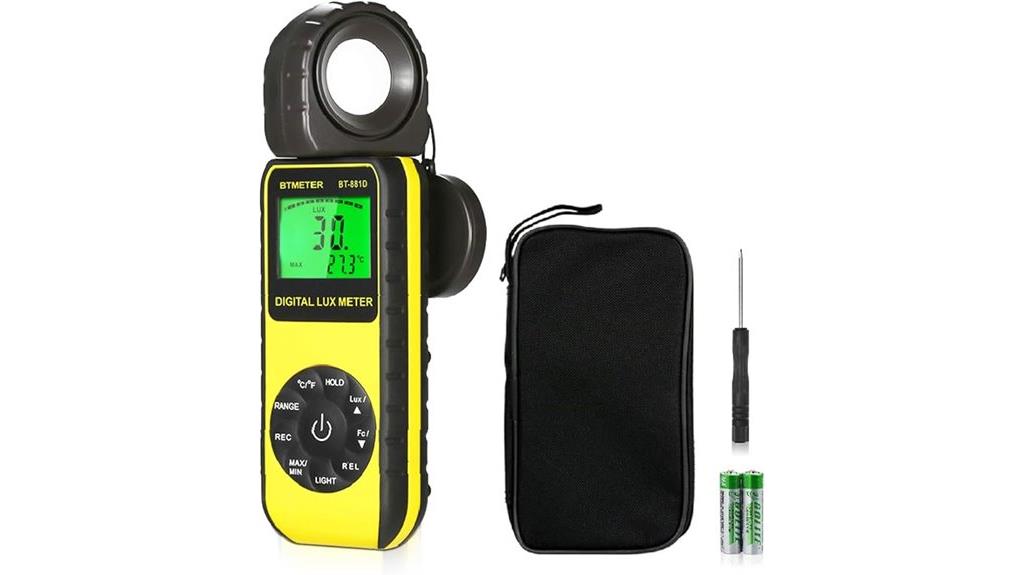
The BTMETER BT-881D Digital Illuminance Light Meter stands out as the ideal choice for photographers, indoor gardeners, and lighting professionals seeking precise light measurements. With a remarkable range of 0.01 to 400,000 Lux, it caters to various lighting conditions, whether indoors or outdoors. I love the 270º rotatable sensor, allowing me to measure light from any angle effortlessly. Plus, it memorizes up to 33 readings, making it great for tracking changes over time. While some users noted minor accuracy issues with LED light, its overall performance and user-friendly features have earned it a solid 4.4-star rating.
Best For: Photographers, indoor gardeners, and lighting professionals seeking precise light measurements in various conditions.
Pros:
- User-friendly features such as a rotatable sensor for versatile angle measurements and the ability to memorize up to 33 readings.
- Wide measurement range from 0.01 to 400,000 Lux, suitable for both indoor and outdoor use.
- Solid customer feedback with a 4.4-star rating, highlighting its performance for light studies and indoor growing.
Cons:
- Some users reported accuracy issues when measuring LED light.
- There may be minor limitations in temperature sensor settings affecting readings.
- Initial learning curve for users unfamiliar with light meters and their functions.
Light Meter Digital Illuminance Meter
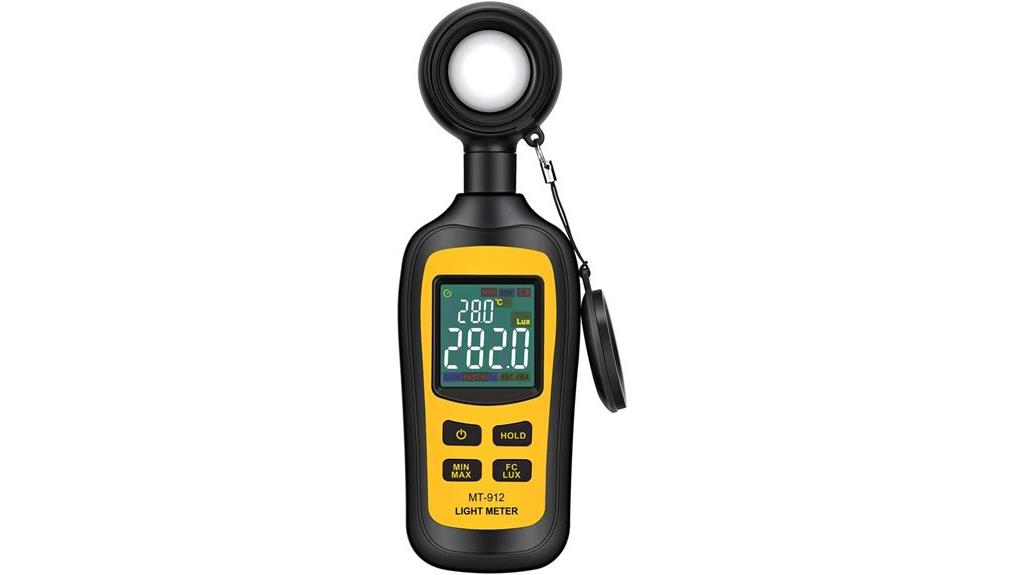
For anyone needing precise lighting measurements, the Light Meter Digital Illuminance Meter stands out as a top choice in 2025. It measures luminosity from 0 to 200,000 Lux with impressive accuracy. I love its user-friendly 4-digit color LCD screen that displays MIN/Max readings and data hold. It’s lightweight and compact, perfect for various settings like homes or offices. I’ve found it particularly helpful for plant care, ensuring ideal light exposure. While some users question its absolute accuracy, the overall feedback is positive, making it a reliable tool for anyone serious about lighting. Plus, it comes with a 2-year warranty!
Best For: Individuals and professionals seeking accurate lighting measurements for applications in home, office, or plant care settings.
Pros:
- User-friendly interface with a bright 4-digit color LCD screen for easy reading.
- High accuracy in measuring light levels with a broad range up to 200,000 Lux.
- Lightweight and compact design makes it portable and convenient for various environments.
Cons:
- Some users are unsure about the absolute accuracy without a reference device.
- Primarily designed for incandescent lights, which may affect performance with other light types.
- Reading variations can occur based on the angle of measurement.
Dr.meter LX1330B Digital Illuminance Light Meter
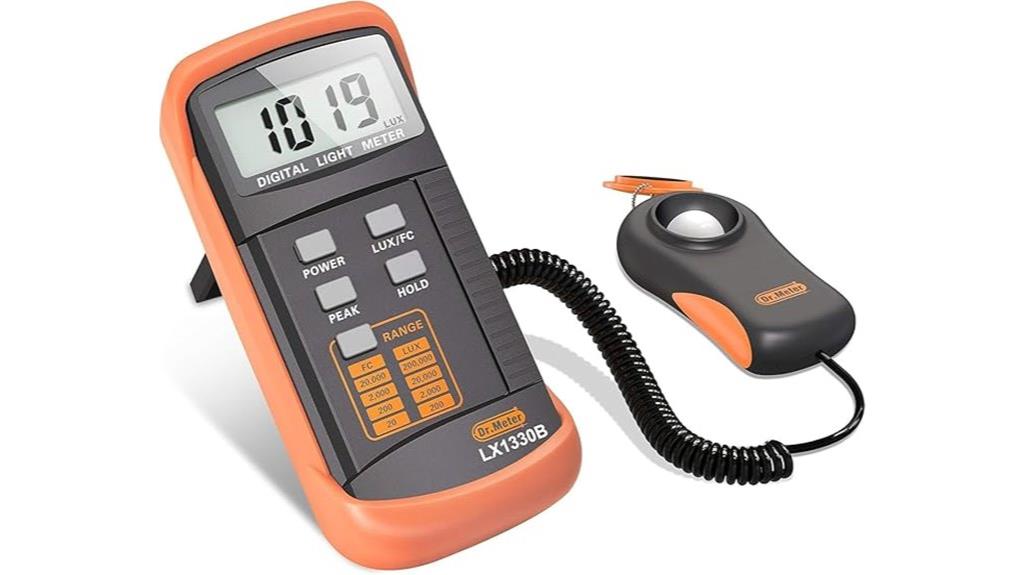
Measuring light intensity accurately is essential for anyone involved in lighting design, making the Dr.meter LX1330B Digital Illuminance Light Meter an excellent choice. With a range of 0-200,000 Lux, it’s perfect for both indoor and outdoor settings, whether you’re working in homes, offices, or greenhouses. I appreciate its high precision, providing readings twice per second. The ability to switch between FC and Lux units makes it versatile for my needs. Plus, the PEAK data recording feature is invaluable for capturing brief bursts of light. Users generally find it easy to operate, making it a reliable tool for lighting projects.
Best For: The Dr.meter LX1330B Digital Illuminance Light Meter is best for lighting designers, horticulturists, and anyone needing precise light measurements in various environments.
Pros:
- High precision with readings at 2 times per second ensures accurate data for lighting projects.
- Dual measurement units (FC and Lux) allow for easy customization based on user preference.
- PEAK data recording feature is useful for capturing brief high-intensity light bursts.
Cons:
- Some users report that instructions for battery installation and range settings could be clearer.
- The LCD display lacks advanced features like backlighting, making it less user-friendly in low-light conditions.
- While generally well-built, the meter’s durability could be a concern for heavy-duty use.
Klein Tools ET130 Digital Light Meter
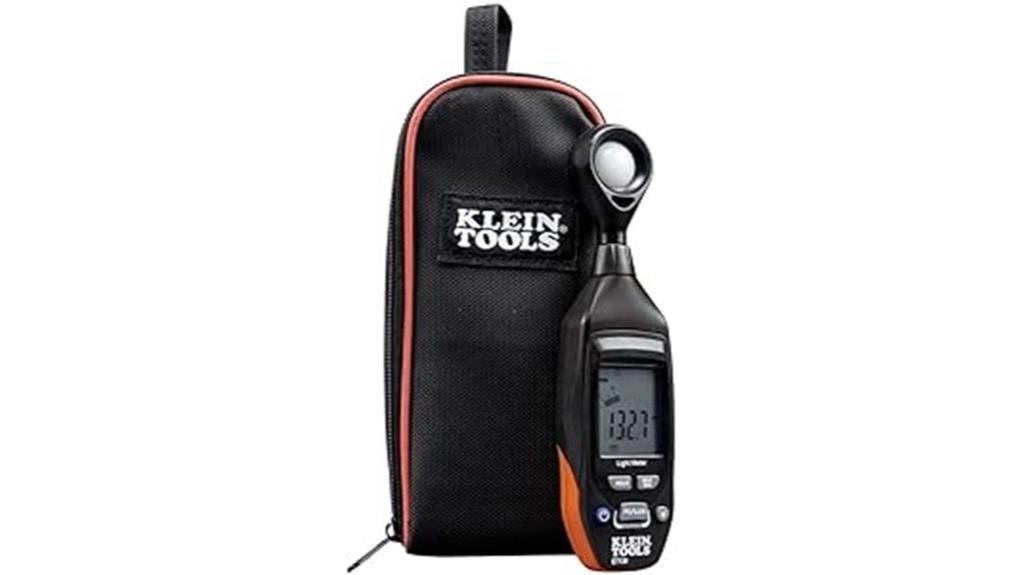
Klein Tools ET130 Digital Light Meter stands out as an excellent choice for professionals and enthusiasts who need precise illuminance measurements. I love its user-friendly design, featuring a backlit LCD display and a 40-segment bar graph that makes reading easy. It accurately measures in Foot Candles and Lux, with both auto and manual range options up to 40,000 Lux. The data hold and Max/Min readings are incredibly handy, and the auto power-off feature helps save battery life. Weighing just 5.5 ounces, it’s portable and comes with a carrying pouch. Klein Tools’ reliable reputation adds even more value to this fantastic device.
Best For: Professionals and enthusiasts seeking precise illuminance measurements for various applications such as inspections and greenhouse lighting.
Pros:
- Accurate measurements in both Foot Candles and Lux.
- User-friendly design with a backlit LCD display and bar graph for easy reading.
- Lightweight and portable, includes a carrying pouch and 9V battery.
Cons:
- Limited to a maximum range of 40,000 Lux, which may not suffice for all applications.
- Some users might find the auto range feature less intuitive.
- Requires a 9V battery, which may not be as commonly available as other battery types.
Digital Illuminance Light Meter Tester (200,000Lux)
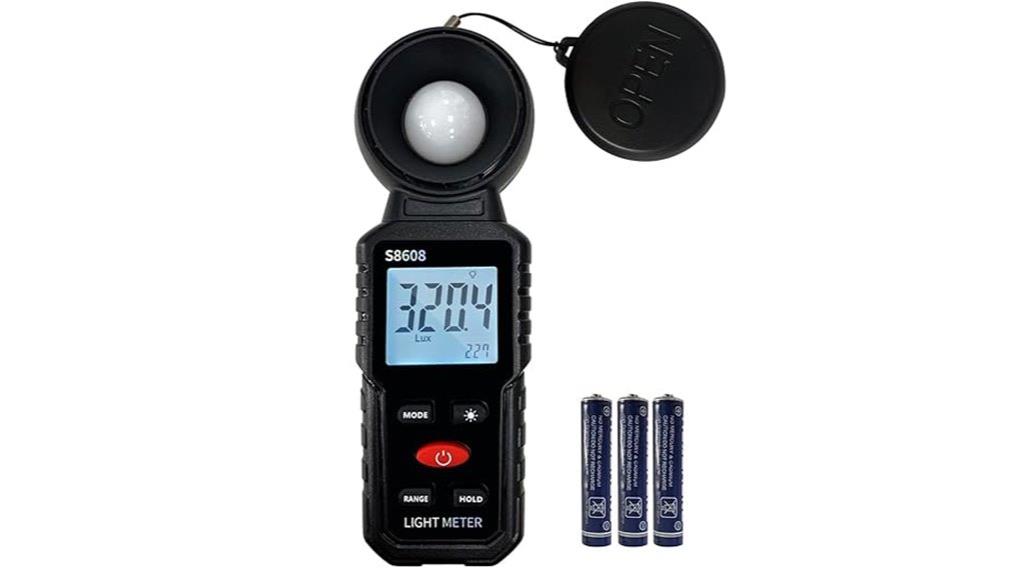
The Digital Illuminance Light Meter Tester, boasting a remarkable measurement capacity of up to 200,000 Lux, stands out as an excellent choice for casual users and hobbyists alike. I love how it easily switches between Lux and Foot-Candles, making it versatile for various applications. Whether I’m measuring light in my home, school, or for indoor plant growth, its MAX/MIN function and data hold feature are incredibly handy. The backlight makes it easy to read in low-light conditions. While it may not be perfect for dim environments, it certainly offers great value for those not needing high-end specs.
Best For: Casual users and hobbyists looking for an affordable and reliable light meter for various settings.
Pros:
- Easy to switch between Lux and Foot-Candles, enhancing versatility for different applications.
- Features like MAX/MIN measurement, data hold, and backlight improve usability in varying conditions.
- Great value for the price, making it suitable for indoor plant growth and general brightness measurement.
Cons:
- May provide lower readings in dim conditions compared to more expensive models.
- Not designed for precise measurements of lumens directly from light sources.
- Some users reported occasional device malfunctions, such as readings dropping to zero.
Light Meter for Vintage Cameras
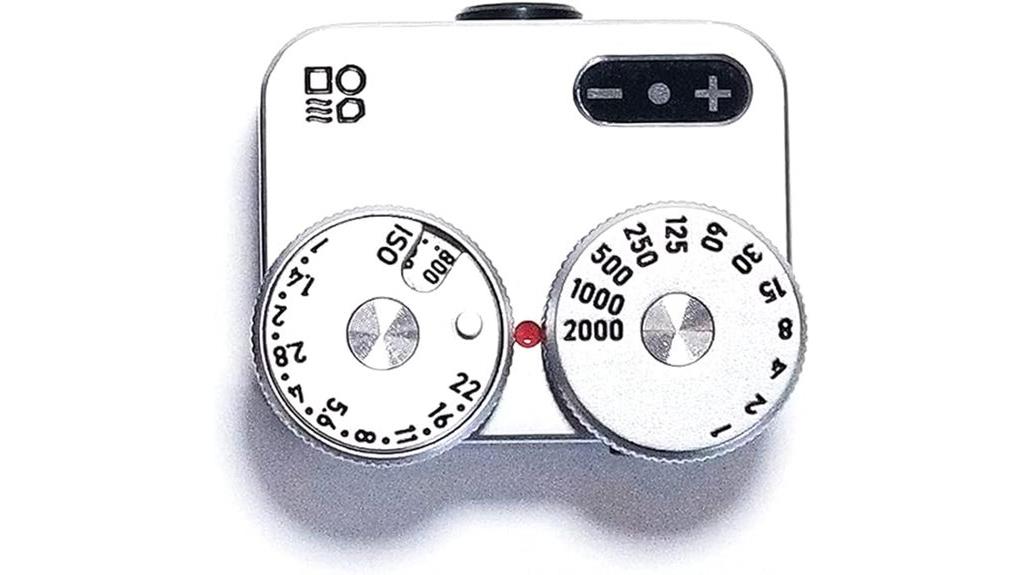
For those who cherish the art of vintage photography, the DOOMO MADE Light Meter, Meter D, stands out as an essential tool. Its all-metal construction and ultra-high accuracy make it a reliable choice for older Leicas and similar rangefinder cameras. I love the adjustable hotshoe mount, which allows for convenient placement, and the three dials for ISO, aperture, and shutter speed settings are incredibly user-friendly. Plus, the LED indicators let you know when you’ve achieved the correct measurement. Weighing just 2.12 ounces, it’s compact enough to carry wherever my vintage adventures take me.
Best For: Vintage photography enthusiasts seeking a high-accuracy light meter for their older Leicas and rangefinder cameras.
Pros:
- All-metal construction ensures durability and a classic aesthetic.
- User-friendly design with adjustable hotshoe mount and clear LED indicators.
- Compact and lightweight, making it easy to carry on photography outings.
Cons:
- Requires a specific 1 C battery, which may not be readily available everywhere.
- May not be compatible with modern cameras, limiting its usability.
- Feedback on pricing competitiveness suggests it might not be the most affordable option.
UNI-T Light Meter UT383BT for Illuminance Measurement

Measuring light intensity can be essential for anyone serious about gardening or photography, and that’s where the UNI-T Light Meter UT383BT shines. This compact device accurately measures light in Lux and Foot Candles, with a remarkable ±(4% + 8) accuracy. Its Bluetooth connectivity lets me transfer data to the iENV App, making light management effortless. The 4-digit LCD screen is easy to read, even in low light. I’ve found it incredibly useful for optimizing light levels for my plants, leading to healthier growth. Plus, it’s budget-friendly, durable, and comes with reliable support. Overall, it’s a great investment for light measurement.
Best For: The UNI-T Light Meter UT383BT is best for gardeners and photographers who require precise light measurement for optimal plant growth and effective lighting in their projects.
Pros:
- High accuracy of ±(4% + 8) for reliable light measurements.
- Bluetooth connectivity for easy data transfer and remote monitoring via the iENV App.
- Compact design with a large, backlit LCD screen for easy readability.
Cons:
- Limited to specific light measurement ranges (0-199,900 Lux and 0-18,500 Foot Candles).
- May require a learning curve for users unfamiliar with light measurement terminology.
- Dependence on the iENV App for advanced data management may not appeal to all users.
Sekonic L-308X-U Flashmate Light Meter (401-305)
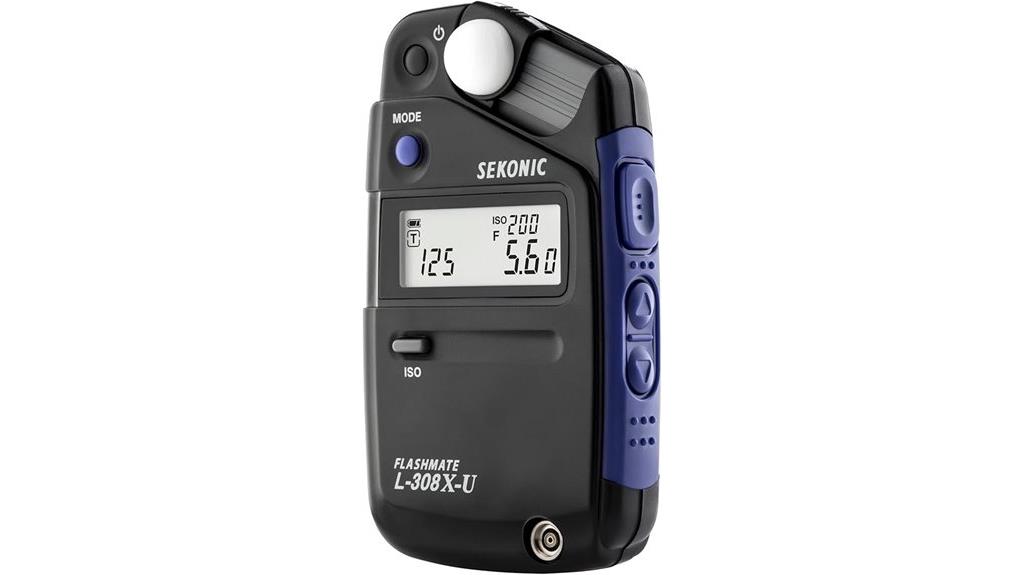
Pocket-sized and packed with features, the Sekonic L-308X-U Flashmate Light Meter (401-305) is perfect for both budding photographers and seasoned professionals. With its accuracy to a tenth-of-a-stop, I find it incredibly reliable for both ambient and flash readings. It covers an ISO range from 3 to 8000, making it versatile for various lighting conditions. The HD Cine Mode is a game-changer for videographers, while the incident and reflected light modes provide flexibility. Plus, its lightweight design and included pouch make it easy to carry everywhere. Overall, it’s a fantastic investment for anyone serious about photography or videography.
Best For: The Sekonic L-308X-U Flashmate Light Meter is best for photographers and videographers looking for a reliable and portable tool to achieve accurate exposure readings in various lighting conditions.
Pros:
- Accurate readings: Provides exposure accuracy to a tenth-of-a-stop for both ambient and electronic flash light.
- Versatile modes: Features multiple modes for photography and videography, including HD Cine Mode for filmmakers.
- Portable design: Lightweight and pocket-sized, making it easy to carry and ideal for on-the-go shooting.
Cons:
- Battery requirement: Operates on a single AA battery which is not included, adding an extra cost.
- Limited high-end features: May lack some advanced functionalities found in more expensive light meters.
- Learning curve for some: While generally easy to use, beginners may still take some time to fully understand all features.
TS-710 Light Meter with 180º Rotating Sensor
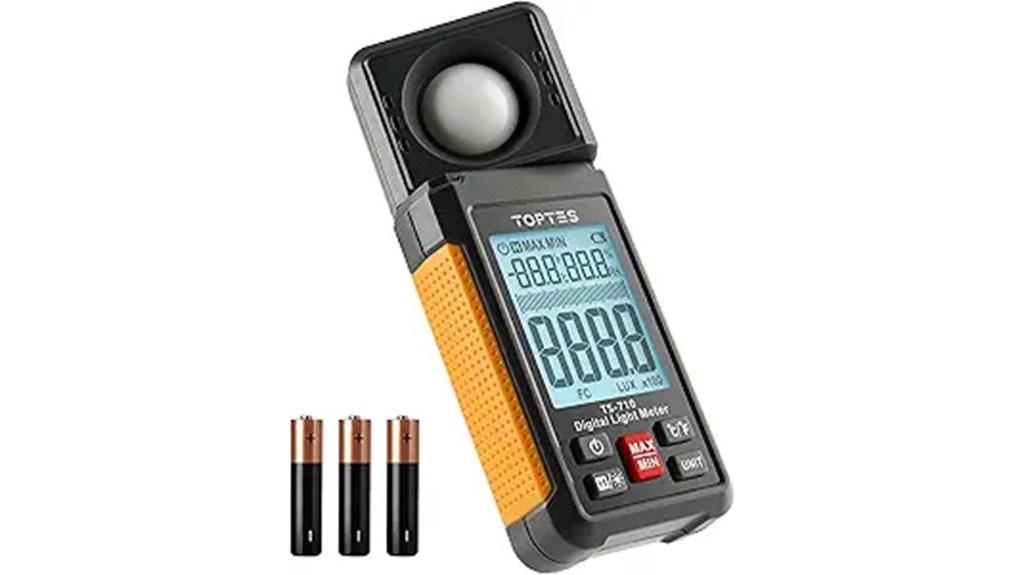
The TS-710 Light Meter stands out with its innovative 180° rotating sensor, making it an ideal choice for photographers, horticulturists, and lighting professionals alike. With a measurement range of 0.1 to 200,000 lux, it delivers precise readings that I’ve found invaluable for various lighting scenarios. The backlit LCD is easy to read, even in low light. Plus, its multi-functional design measures temperature and humidity, enhancing its versatility. I appreciate the data recording features for MAX/MIN values, and the auto shut-off saves battery life. Overall, the TS-710 has truly elevated my lighting assessments and plant care techniques.
Best For: Photographers, horticulturists, and lighting professionals seeking accurate light measurements and environmental data.
Pros:
- Multi-functional design that measures light, temperature, and humidity for comprehensive assessments.
- High accuracy with a measurement range up to 200,000 lux, making it suitable for various lighting environments.
- User-friendly features such as a backlit LCD display, data recording, and auto shut-off to enhance usability.
Cons:
- Some users have reported issues with temperature accuracy, which may affect certain applications.
- The battery life may diminish if the auto shut-off feature is not utilized.
- The size of the display could be considered small for individuals who prefer larger screens for visibility.
BTMETER BT-881D Digital Illuminance Light Meter
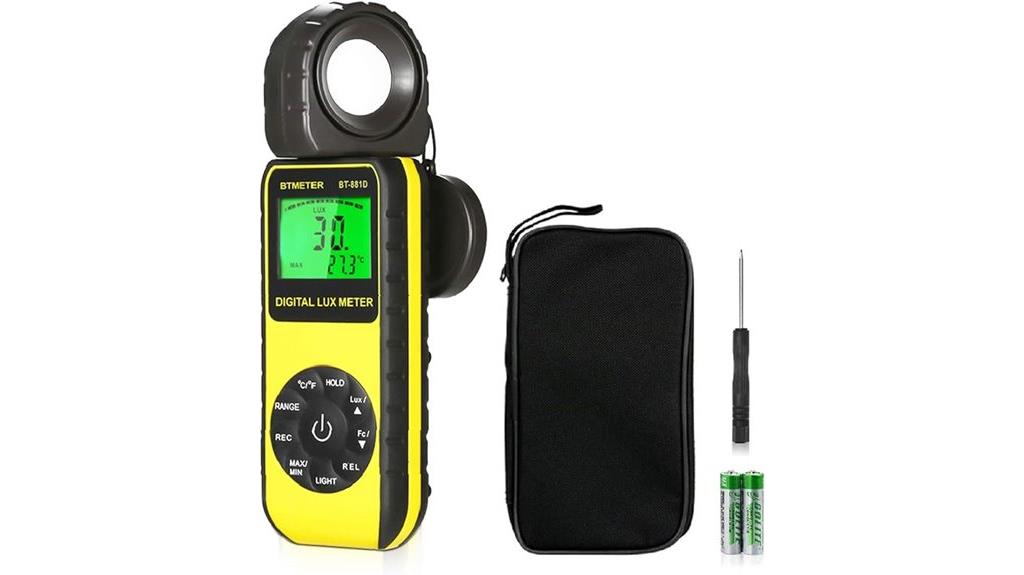
For anyone serious about lighting conditions—especially indoor gardeners and photographers—the BTMETER BT-881D Digital Illuminance Light Meter stands out with its impressive measurement range of 0.01 to 400,000 Lux. I love the 270º rotatable sensor, which lets me measure light from various angles without fuss. With an accuracy of +/- 4% at 10,000 Lux, it’s reliable for my light studies. Plus, it memorizes up to 33 readings, making comparisons a breeze. While some users note accuracy issues with LED lights, its overall performance and user-friendly design have earned it a solid 4.4-star rating. It’s a fantastic tool for anyone!
Best For: Indoor gardeners and photographers looking for accurate light measurements in various settings.
Pros:
- 270º rotatable sensor allows for versatile angle measurements.
- Memorizes up to 33 readings for easy comparisons and analysis.
- High accuracy of +/- 4% at 10,000 Lux, suitable for detailed light studies.
Cons:
- Some users report accuracy issues with LED light measurements.
- Performance may vary depending on temperature sensor settings.
- Limited functionality for outdoor conditions compared to specialized outdoor meters.
Mcbazel Digital Illuminance Light Meter for Photography and Gardening
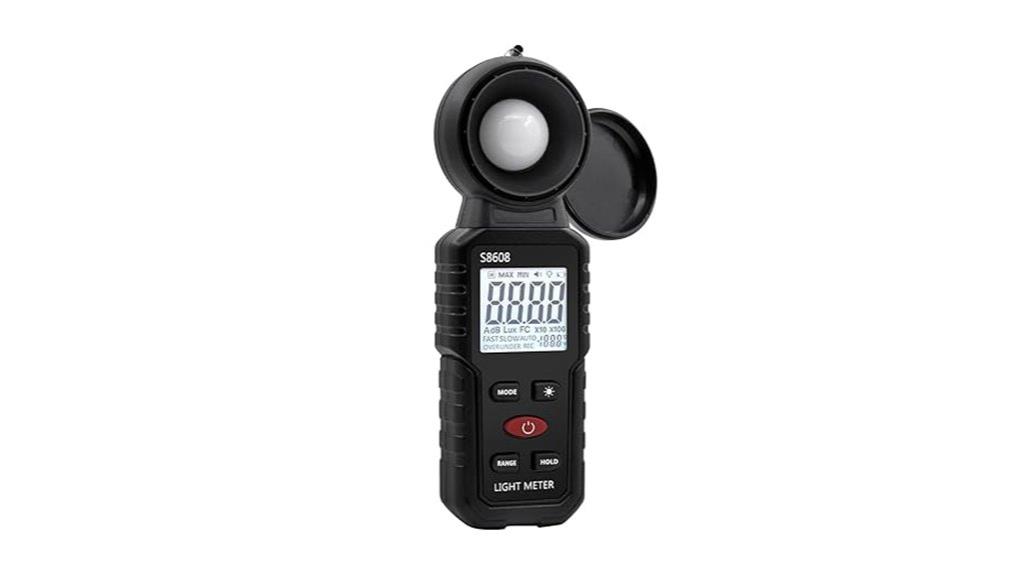
Measuring light intensity accurately is essential for photographers and gardeners alike, and the Mcbazel Digital Illuminance Light Meter excels in this area. With a range of up to 200,000 Lux and impressive accuracy, it’s perfect for various lighting conditions. I love the user-friendly features, like the easy switch between LUX and FC units and the backlit LCD display for low-light situations. Plus, the data hold function is great for recording readings. It’s compact and lightweight, making it easy to carry. For its affordable price, the durability and performance make the Mcbazel an outstanding choice for anyone serious about light measurement.
Best For: The Mcbazel Digital Illuminance Light Meter is best for photographers, gardeners, and anyone needing precise light measurements in various environments.
Pros:
- High accuracy with a measurement range of up to 200,000 Lux, suitable for diverse lighting conditions.
- User-friendly features including easy unit switching, a backlit display, and a data hold function for convenient recording.
- Compact and lightweight design makes it portable, ideal for on-the-go use in photography and gardening.
Cons:
- Requires 3 x AAA batteries which are not included, adding to ongoing maintenance costs.
- Limited functionality may not meet the needs of highly specialized lighting professionals.
- Automatic shut-off feature may interrupt usage if not careful about power management.
Light Meter Digital Illuminance Meter
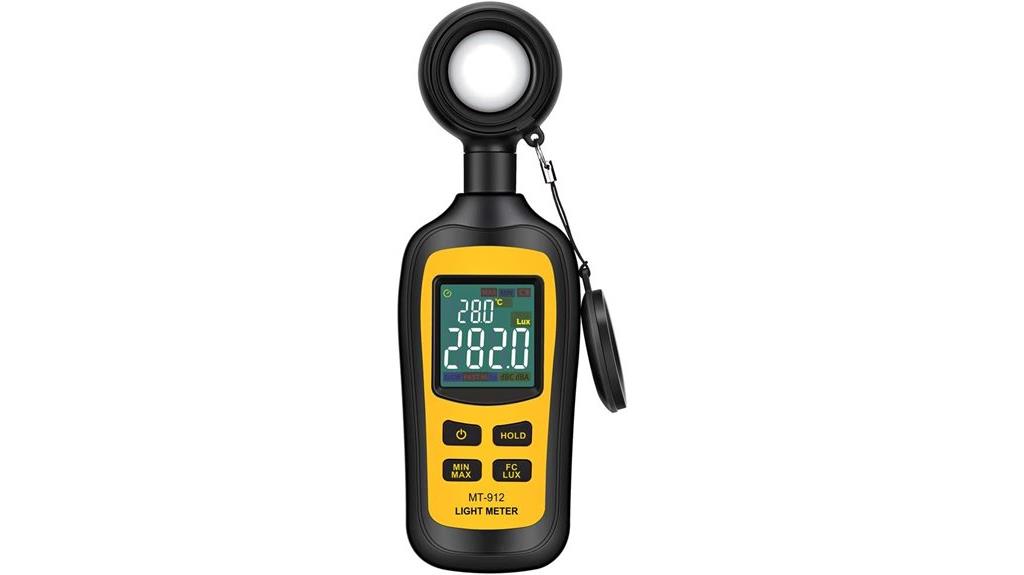
With its ability to measure luminosity from 0 to 200,000 Lux, the Light Meter Digital Illuminance Meter stands out as an essential tool for photographers, designers, and plant enthusiasts alike. I love its lightweight design and user-friendly interface, making it a breeze to use. The clear 4-digit LCD screen displays MIN/Max readings, and the accuracy is impressive, especially for indoor lighting. I’ve found it invaluable in determining the right light for my houseplants. Though it’s mainly designed for incandescent lights, its versatility makes it perfect for various settings. With a 2-year warranty, you can’t go wrong with this reliable meter!
Best For: Photographers, designers, and plant enthusiasts looking for an accurate and user-friendly light measurement tool.
Pros:
- Lightweight and compact design makes it easy to carry and use in various settings.
- High accuracy in light measurements, especially for indoor lighting.
- Clear 4-digit LCD screen with useful features like MIN/Max readings and data hold.
Cons:
- Primarily designed for incandescent lights, which may affect performance with other light types.
- Some users report uncertainty about absolute accuracy without a reference machine.
- Reading variations may occur based on the angle of measurement.
OLED Light Meter for Vintage Cameras
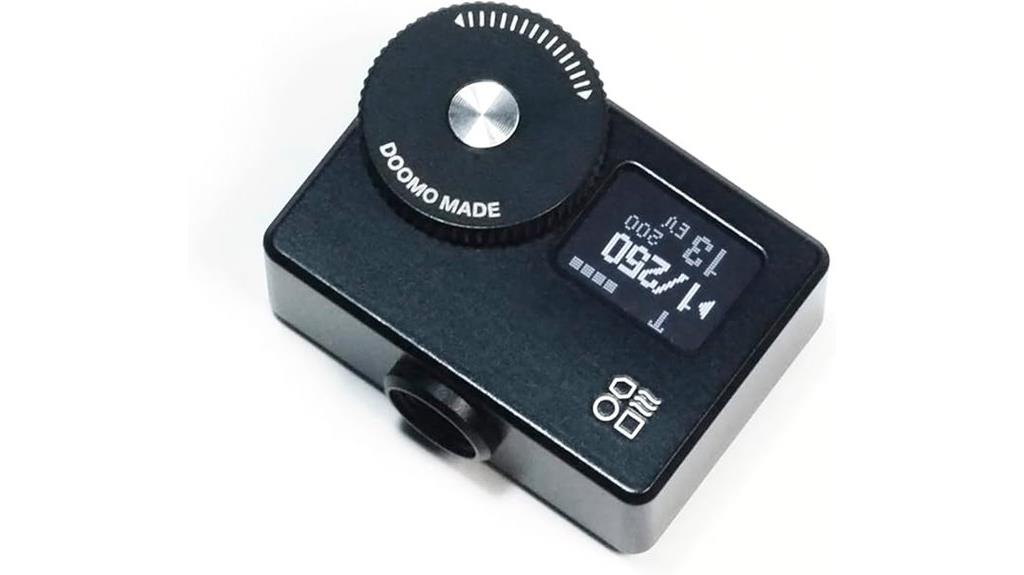
The DOOMO OLED Light Meter stands out as an excellent choice for vintage camera enthusiasts seeking precision and portability. With its ultra-high metering accuracy and compact design, it fits easily in my pocket. The 0.66-inch OLED display is bright and clear, making it easy to read in various lighting conditions. I appreciate the switchable metering modes, which allow for flexibility in my shooting style. However, I’ve faced issues with shutter speed and aperture syncing, requiring manual shutdown. Despite these quirks, its lightweight, chrome finish adds a touch of style to my vintage gear, making it a handy companion for any shoot.
Best For: Vintage camera enthusiasts seeking a portable and precise light metering solution.
Pros:
- Ultra-high metering accuracy allows for precise exposure settings.
- Compact design makes it easy to carry and fits in a pocket.
- Switchable metering modes provide flexibility for various shooting styles.
Cons:
- Shutter speed and aperture syncing issues can hinder usability.
- Requires manual shutdown, which can be inconvenient.
- Customer dissatisfaction due to unresolved bugs and lack of software improvements.
UNI-T UT383 Light Meter for Film Photography and Lighting Measurement
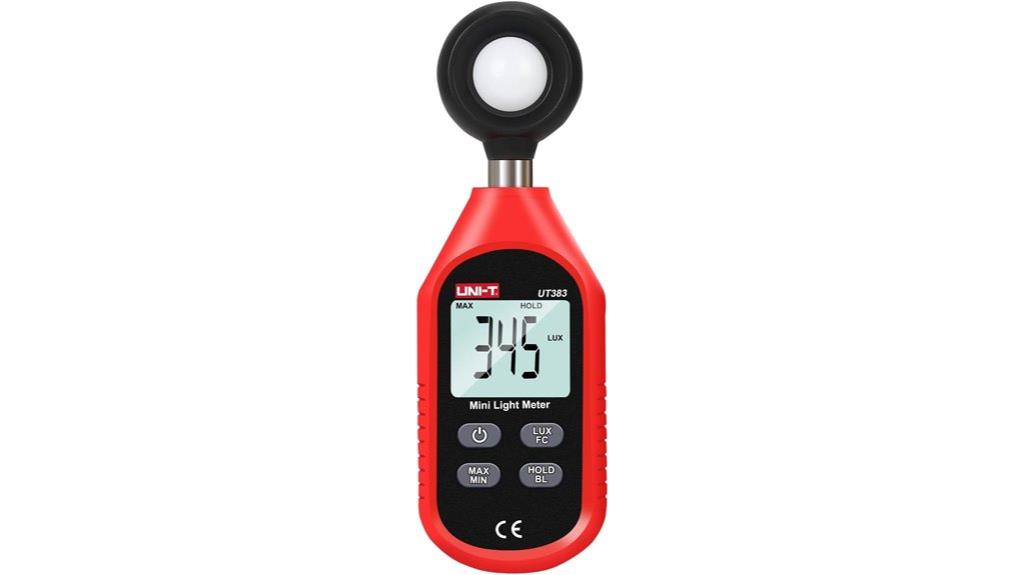
For anyone deeply invested in film photography or precise lighting measurement, the UNI-T UT383 Light Meter stands out as an exceptional choice in the “Best Light Meters of 2025” lineup. Its ability to measure light intensity in both Lux and Foot Candles, combined with high accuracy and a compact design, makes it incredibly user-friendly. The large LCD screen with backlight guarantees visibility in any lighting condition. I appreciate features like overload indication and Max/Min data hold, making it versatile for various applications. Plus, with a solid customer rating and 24/7 support, it’s a reliable tool for both amateurs and professionals alike.
Best For: The UNI-T UT383 Light Meter is best for film photographers and professionals in various lighting measurement fields seeking accuracy and ease of use.
Pros:
- High accuracy with a measurement range suitable for diverse applications, including photography and plant growth.
- Compact design with a large backlit LCD screen for visibility in low-light conditions.
- Excellent customer support available 24/7 and a solid average rating from users.
Cons:
- Limited measurement range may not satisfy specialized professional needs in extreme lighting conditions.
- Some users may find the compact size less comfortable for prolonged use.
- Battery life could be a concern for intensive long-term usage without a replaceable option.
Factors to Consider When Choosing Light Meters
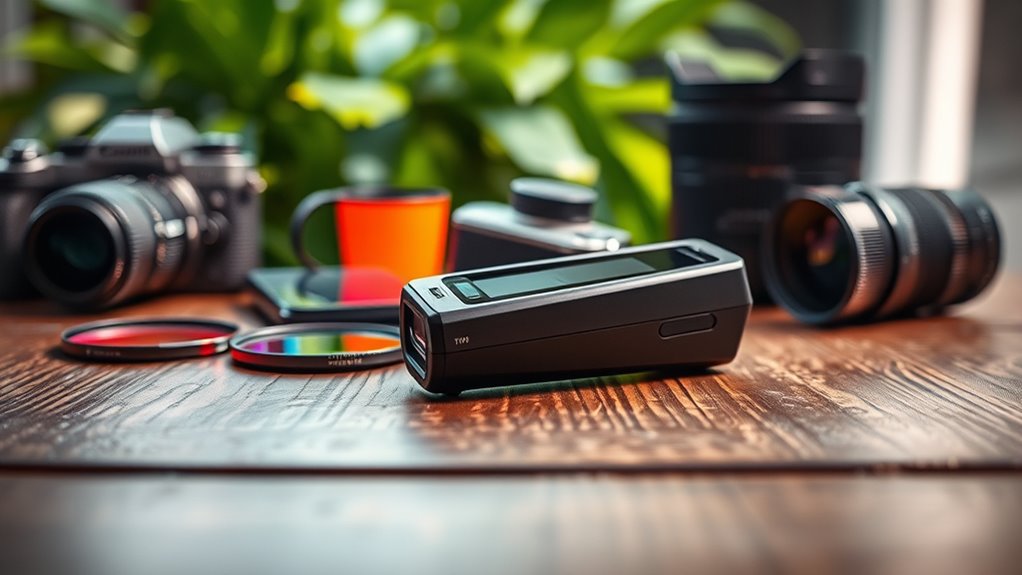
When I’m choosing a light meter, I always consider several key factors that can really impact my work. The measurement range, accuracy, portability, and user-friendly features all play a role in how effective the meter will be for my specific needs. Plus, I think about how versatile the meter is for different applications, as that can really enhance my shooting experience.
Measurement Range Options
Choosing the right measurement range for your light meter is vital for getting accurate readings in various environments. Light meters can measure light intensity in units like Lux and Foot Candles, with ranges from as low as 0.01 Lux to over 400,000 Lux. If you’re into indoor growing or photography, you’ll need a meter with higher sensitivity to capture those subtle light variations. Keep in mind that a wider measurement range offers versatility, allowing you to assess both low light and intense illumination. Additionally, consider the resolution of the meter—some models provide a finer granularity, which is essential for detailed assessments. Ultimately, matching the meter’s range to your specific needs guarantees reliable and precise readings.
Accuracy and Precision
While selecting a light meter, it’s vital to take into account both accuracy and precision to guarantee reliable measurements. Accuracy is often shown as a percentage error, with many meters ranging from ±3% to ±5% for readings above 10,000 Lux. Precision, on the other hand, reflects how consistently a meter can replicate measurements, and some models can deliver readings multiple times per second. Remember that different light sources can affect accuracy; for example, LED lights might yield different results compared to incandescent bulbs. Calibration is also important, as some meters let you adjust settings for specific conditions. Finally, don’t overlook the display readability, since poor visibility in bright or dim environments can impact your measurements notably.
Portability and Design
Portability and design are essential factors in selecting a light meter that suits my needs, as I often find myself on the move. I prefer lightweight models that weigh between 5.5 to 12 ounces, making them easy to carry during long shoots. A compact design, ideally around 6 to 8 inches in length, guarantees my light meter fits snugly in my bag or pocket, ready for quick access. I appreciate well-placed buttons and clear displays, which enhance usability in different lighting conditions. Features like backlit LCD screens are a plus, improving visibility in low-light environments. Ergonomic designs and included carrying cases further enhance my experience, providing protection and making my light meter even more convenient to transport.
User-Friendly Features
When I’m selecting a light meter, user-friendly features play an important role in guaranteeing I get accurate readings quickly and effortlessly. I always look for models with a backlit LCD display, which makes visibility a breeze in low-light conditions. Having both auto and manual range options is vital, as it lets me choose the most suitable measurement scale for my needs. Data hold functionality is a must for freezing readings, so I can jot them down without constant observation. I also prefer devices with memory functions to save multiple readings, making it easy to compare light levels later. Finally, I verify the meter is lightweight and portable, allowing me to use it in various environments, whether I’m gardening indoors or shooting outdoors.
Application Versatility
Choosing the right light meter involves considering how versatile it is for different applications, since the range of measurements can greatly impact your results. I recommend checking the measurement range; some meters can read as low as 0.01 Lux up to 400,000 Lux, making them perfect for everything from indoor gardening to professional photography. Features like dual measurement units (Lux and Foot Candles) offer flexibility for various lighting scenarios. A rotatable sensor enhances usability, allowing you to take readings from different angles without moving the device. Additionally, data logging capabilities let you store multiple readings for future comparisons. Finally, opt for a meter with quick response times, ideally 0.4 seconds or faster, to guarantee accuracy in changing lighting conditions.
Frequently Asked Questions
How Do Light Meters Improve Photography Skills?
Light meters really enhance my photography skills by helping me understand exposure better. They provide precise readings of light in different conditions, allowing me to adjust my settings accurately. I’ve noticed that using a light meter helps me avoid overexposed or underexposed shots, leading to more balanced images. By trusting the meter’s advice, I can focus more on composition and creativity, knowing I’m getting the exposure right every time. It’s a game changer!
Can I Use a Smartphone as a Light Meter?
Absolutely, you can use a smartphone as a light meter! I’ve done it many times, and it works surprisingly well. There are several apps available that measure light levels and help you adjust your exposure settings. While it might not be as precise as a dedicated light meter, it gets the job done for casual photography. Just remember to calibrate the app if you can, and you’ll get decent readings!
What’S the Difference Between Incident and Reflective Light Meters?
When it comes to light meters, understanding the difference between incident and reflective meters is key. An incident meter measures light falling on a subject, giving you a reading that reflects the lighting conditions. A reflective meter, on the other hand, measures light bouncing off the subject, which can be influenced by the subject’s color and texture. I often find that using both types helps me achieve a balanced exposure in my photography.
Are Light Meters Necessary for Beginners in Photography?
When I first started photography, I didn’t think light meters were necessary. However, I’ve since realized they can really help beginners. They take the guesswork out of exposure, allowing you to focus on composition and creativity. Using a light meter, I learned to understand how light works and improved my skills faster. So, while they’re not essential, having one can definitely boost your confidence and enhance your photography journey.
How Often Should I Calibrate My Light Meter?
I calibrate my light meter regularly to guarantee accurate readings. I usually check it every six months, especially if I notice any inconsistencies in my exposures. It’s a good practice to test it whenever I change my shooting environment or use a different lens. Keeping it calibrated helps me capture the best possible images without second-guessing my settings. Trust me, taking that time can really enhance your photography experience!
Conclusion
So, there you have it—15 fantastic light meters to elevate your photography game in 2025! It’s fascinating how light meters, once seen as mere tools, have become essential companions for photographers. They help us capture the perfect shot by measuring light accurately. I’ve found that investing in a quality meter can truly transform your approach to photography. So, why not give one a try and see how it changes your creative process? You might just surprise yourself!
